Effective Teamwork: Workplace Communication Strategies Report
VerifiedAdded on 2022/10/10
|12
|3046
|56
Report
AI Summary
This report delves into the critical aspects of effective teamwork, examining the various barriers to communication that can hinder workplace productivity and collaboration. It identifies physical, emotional, cultural, and language barriers, providing real-world examples to illustrate their impact. The report also explores the reasons behind poor communication, including lack of leadership, unclear goals, undertrained employees, and limited feedback mechanisms. Furthermore, it evaluates the detrimental effects of poor communication, such as increased stress, unmet expectations, relational breakdowns, low morale, and potential health issues. Finally, the report outlines several strategies for effective communication, including face-to-face interactions, email communication, business meetings, and the use of social media applications, offering practical solutions for fostering a more communicative and collaborative work environment. This report provides valuable insights into improving teamwork and enhancing overall organizational success.

Running head: EFFECTIVE TEAMWORK
Effective Teamwork
Effective Teamwork
Paraphrase This Document
Need a fresh take? Get an instant paraphrase of this document with our AI Paraphraser
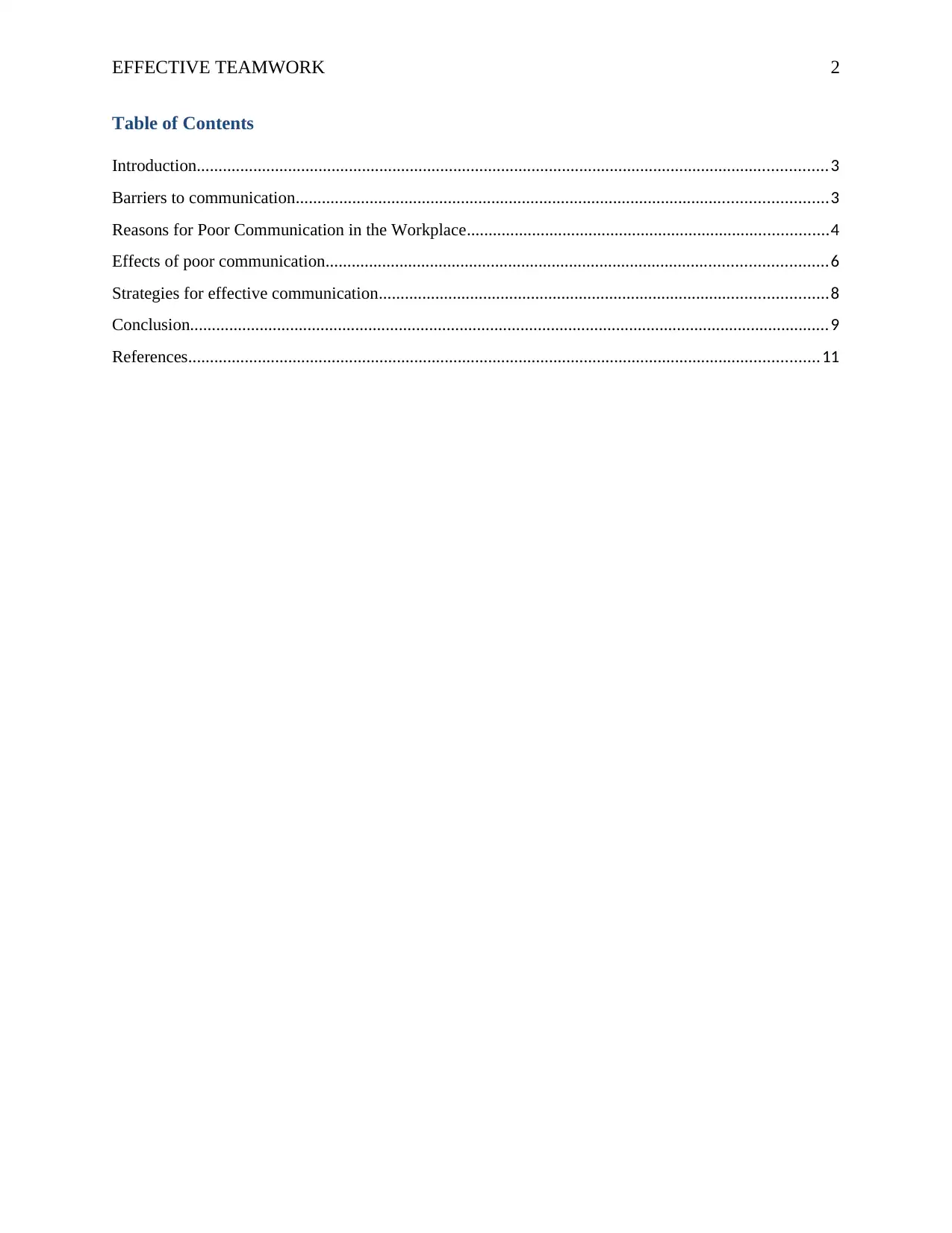
EFFECTIVE TEAMWORK 2
Table of Contents
Introduction.................................................................................................................................................3
Barriers to communication..........................................................................................................................3
Reasons for Poor Communication in the Workplace...................................................................................4
Effects of poor communication...................................................................................................................6
Strategies for effective communication.......................................................................................................8
Conclusion...................................................................................................................................................9
References.................................................................................................................................................11
Table of Contents
Introduction.................................................................................................................................................3
Barriers to communication..........................................................................................................................3
Reasons for Poor Communication in the Workplace...................................................................................4
Effects of poor communication...................................................................................................................6
Strategies for effective communication.......................................................................................................8
Conclusion...................................................................................................................................................9
References.................................................................................................................................................11
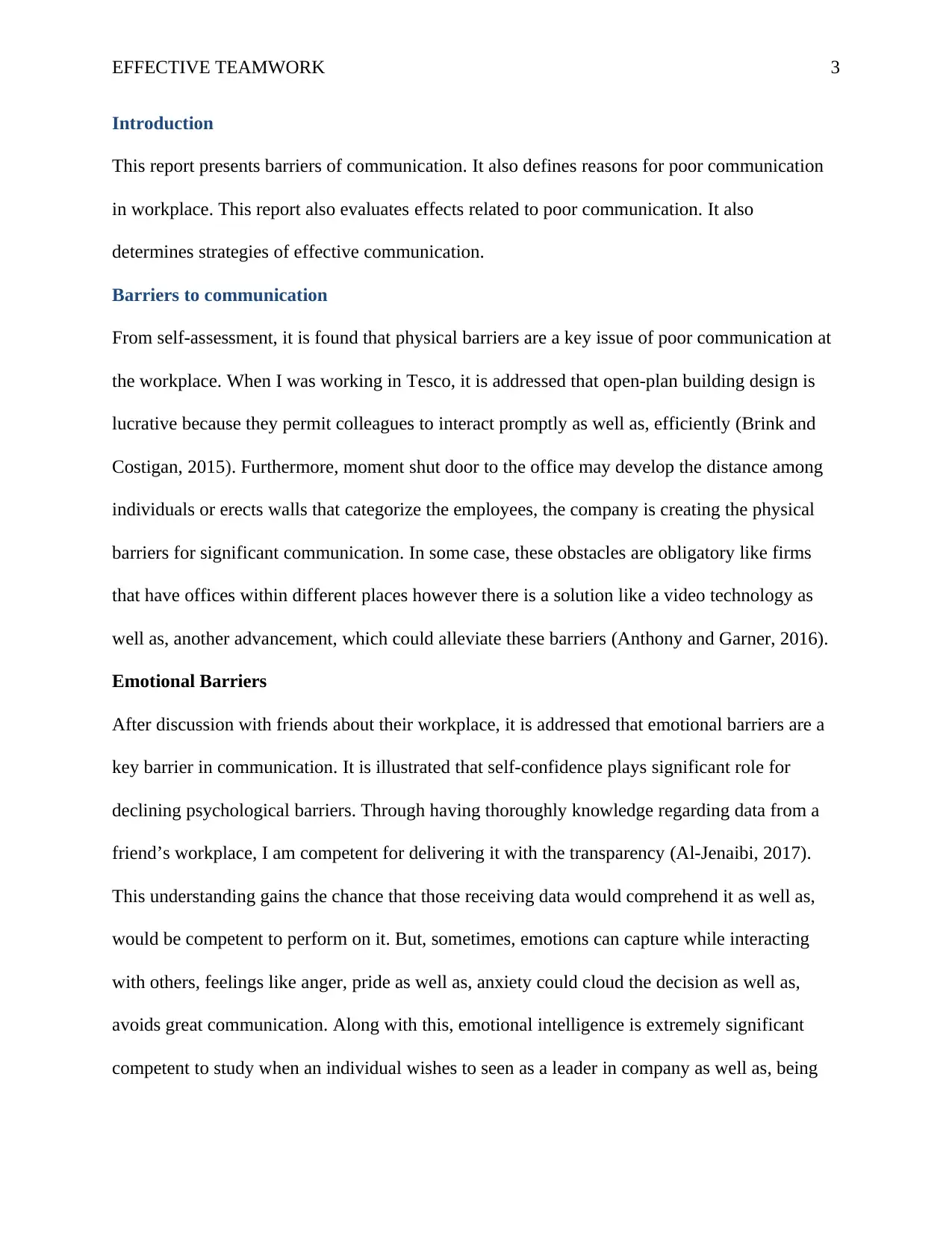
EFFECTIVE TEAMWORK 3
Introduction
This report presents barriers of communication. It also defines reasons for poor communication
in workplace. This report also evaluates effects related to poor communication. It also
determines strategies of effective communication.
Barriers to communication
From self-assessment, it is found that physical barriers are a key issue of poor communication at
the workplace. When I was working in Tesco, it is addressed that open-plan building design is
lucrative because they permit colleagues to interact promptly as well as, efficiently (Brink and
Costigan, 2015). Furthermore, moment shut door to the office may develop the distance among
individuals or erects walls that categorize the employees, the company is creating the physical
barriers for significant communication. In some case, these obstacles are obligatory like firms
that have offices within different places however there is a solution like a video technology as
well as, another advancement, which could alleviate these barriers (Anthony and Garner, 2016).
Emotional Barriers
After discussion with friends about their workplace, it is addressed that emotional barriers are a
key barrier in communication. It is illustrated that self-confidence plays significant role for
declining psychological barriers. Through having thoroughly knowledge regarding data from a
friend’s workplace, I am competent for delivering it with the transparency (Al-Jenaibi, 2017).
This understanding gains the chance that those receiving data would comprehend it as well as,
would be competent to perform on it. But, sometimes, emotions can capture while interacting
with others, feelings like anger, pride as well as, anxiety could cloud the decision as well as,
avoids great communication. Along with this, emotional intelligence is extremely significant
competent to study when an individual wishes to seen as a leader in company as well as, being
Introduction
This report presents barriers of communication. It also defines reasons for poor communication
in workplace. This report also evaluates effects related to poor communication. It also
determines strategies of effective communication.
Barriers to communication
From self-assessment, it is found that physical barriers are a key issue of poor communication at
the workplace. When I was working in Tesco, it is addressed that open-plan building design is
lucrative because they permit colleagues to interact promptly as well as, efficiently (Brink and
Costigan, 2015). Furthermore, moment shut door to the office may develop the distance among
individuals or erects walls that categorize the employees, the company is creating the physical
barriers for significant communication. In some case, these obstacles are obligatory like firms
that have offices within different places however there is a solution like a video technology as
well as, another advancement, which could alleviate these barriers (Anthony and Garner, 2016).
Emotional Barriers
After discussion with friends about their workplace, it is addressed that emotional barriers are a
key barrier in communication. It is illustrated that self-confidence plays significant role for
declining psychological barriers. Through having thoroughly knowledge regarding data from a
friend’s workplace, I am competent for delivering it with the transparency (Al-Jenaibi, 2017).
This understanding gains the chance that those receiving data would comprehend it as well as,
would be competent to perform on it. But, sometimes, emotions can capture while interacting
with others, feelings like anger, pride as well as, anxiety could cloud the decision as well as,
avoids great communication. Along with this, emotional intelligence is extremely significant
competent to study when an individual wishes to seen as a leader in company as well as, being
⊘ This is a preview!⊘
Do you want full access?
Subscribe today to unlock all pages.

Trusted by 1+ million students worldwide
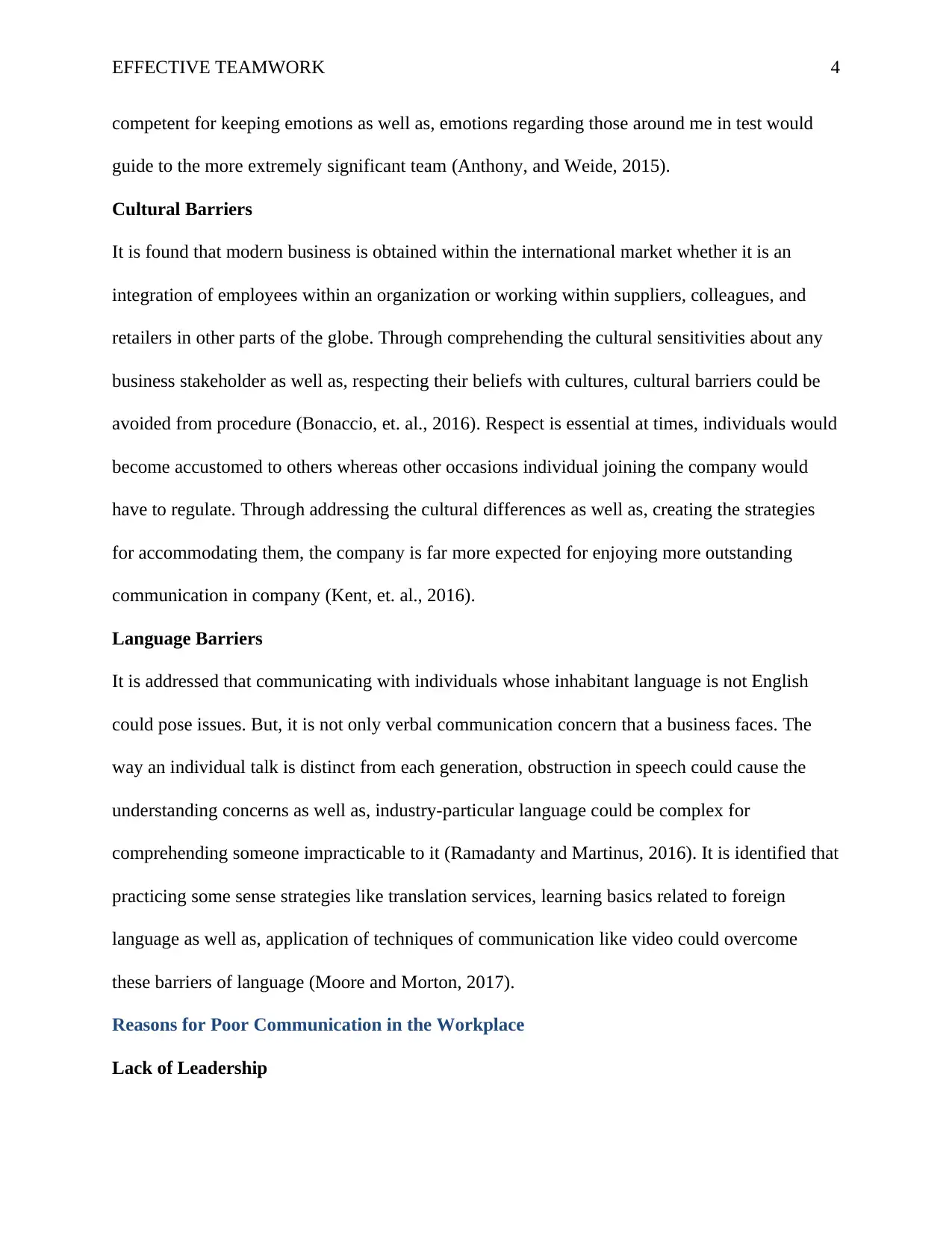
EFFECTIVE TEAMWORK 4
competent for keeping emotions as well as, emotions regarding those around me in test would
guide to the more extremely significant team (Anthony, and Weide, 2015).
Cultural Barriers
It is found that modern business is obtained within the international market whether it is an
integration of employees within an organization or working within suppliers, colleagues, and
retailers in other parts of the globe. Through comprehending the cultural sensitivities about any
business stakeholder as well as, respecting their beliefs with cultures, cultural barriers could be
avoided from procedure (Bonaccio, et. al., 2016). Respect is essential at times, individuals would
become accustomed to others whereas other occasions individual joining the company would
have to regulate. Through addressing the cultural differences as well as, creating the strategies
for accommodating them, the company is far more expected for enjoying more outstanding
communication in company (Kent, et. al., 2016).
Language Barriers
It is addressed that communicating with individuals whose inhabitant language is not English
could pose issues. But, it is not only verbal communication concern that a business faces. The
way an individual talk is distinct from each generation, obstruction in speech could cause the
understanding concerns as well as, industry-particular language could be complex for
comprehending someone impracticable to it (Ramadanty and Martinus, 2016). It is identified that
practicing some sense strategies like translation services, learning basics related to foreign
language as well as, application of techniques of communication like video could overcome
these barriers of language (Moore and Morton, 2017).
Reasons for Poor Communication in the Workplace
Lack of Leadership
competent for keeping emotions as well as, emotions regarding those around me in test would
guide to the more extremely significant team (Anthony, and Weide, 2015).
Cultural Barriers
It is found that modern business is obtained within the international market whether it is an
integration of employees within an organization or working within suppliers, colleagues, and
retailers in other parts of the globe. Through comprehending the cultural sensitivities about any
business stakeholder as well as, respecting their beliefs with cultures, cultural barriers could be
avoided from procedure (Bonaccio, et. al., 2016). Respect is essential at times, individuals would
become accustomed to others whereas other occasions individual joining the company would
have to regulate. Through addressing the cultural differences as well as, creating the strategies
for accommodating them, the company is far more expected for enjoying more outstanding
communication in company (Kent, et. al., 2016).
Language Barriers
It is addressed that communicating with individuals whose inhabitant language is not English
could pose issues. But, it is not only verbal communication concern that a business faces. The
way an individual talk is distinct from each generation, obstruction in speech could cause the
understanding concerns as well as, industry-particular language could be complex for
comprehending someone impracticable to it (Ramadanty and Martinus, 2016). It is identified that
practicing some sense strategies like translation services, learning basics related to foreign
language as well as, application of techniques of communication like video could overcome
these barriers of language (Moore and Morton, 2017).
Reasons for Poor Communication in the Workplace
Lack of Leadership
Paraphrase This Document
Need a fresh take? Get an instant paraphrase of this document with our AI Paraphraser

EFFECTIVE TEAMWORK 5
It is addressed that lack of leadership is a key reason for poor communication within an
organization of my friend. Workforces look to their employers for course, however, when
management lacks leadership competencies, it could stunt the growth of the firm. Consequently,
it has an unfavorable impact on interaction within an organization. Employers who cannot lead
hesitate while, giving instruction to workforces as well as, is often competent for answering and
seeking the answer to the question of workforces (Egloffstein and Ifenthaler, 2017).
Unclear Goals and Duties
It is also identified that unclear goals and duties are the key reason for poor communication.
From the moment of the step of workforces within an organization, they should have adequate
knowledge regarding what is expected in the role they are accomplishing. There are different
jobs that do this by offering workforces with the job description as well as, making a list of
duties (Lindlof and Taylor, 2017). However, it is significant to sit with the workforces as well as,
considers the measurable objectives. Through interact the data to workforces outspoken, it is
easier for workforces for interacting accountabilities, get feedback related to status of enduring
projects as well as, solicit thoughts with shortly proposition (Nabi, et. al., 2017).
Undertrained Employees
It is addressed that undertrained workforces are a key reason for poor communication at
workplace of friends. When workforces are not adequately trained on joining a firm, it could
cause chaos on interactions down line. The workforces should be familiar with company,
responsibilities of each department together as well as, impact of it on overall success of firm,
better workforce is at interacting with management, consumers as well as, co-workers. In
addition, poor training may lead to workforce transferring incorrect information both externally
and internally (Alas and Mousa, 2016).
It is addressed that lack of leadership is a key reason for poor communication within an
organization of my friend. Workforces look to their employers for course, however, when
management lacks leadership competencies, it could stunt the growth of the firm. Consequently,
it has an unfavorable impact on interaction within an organization. Employers who cannot lead
hesitate while, giving instruction to workforces as well as, is often competent for answering and
seeking the answer to the question of workforces (Egloffstein and Ifenthaler, 2017).
Unclear Goals and Duties
It is also identified that unclear goals and duties are the key reason for poor communication.
From the moment of the step of workforces within an organization, they should have adequate
knowledge regarding what is expected in the role they are accomplishing. There are different
jobs that do this by offering workforces with the job description as well as, making a list of
duties (Lindlof and Taylor, 2017). However, it is significant to sit with the workforces as well as,
considers the measurable objectives. Through interact the data to workforces outspoken, it is
easier for workforces for interacting accountabilities, get feedback related to status of enduring
projects as well as, solicit thoughts with shortly proposition (Nabi, et. al., 2017).
Undertrained Employees
It is addressed that undertrained workforces are a key reason for poor communication at
workplace of friends. When workforces are not adequately trained on joining a firm, it could
cause chaos on interactions down line. The workforces should be familiar with company,
responsibilities of each department together as well as, impact of it on overall success of firm,
better workforce is at interacting with management, consumers as well as, co-workers. In
addition, poor training may lead to workforce transferring incorrect information both externally
and internally (Alas and Mousa, 2016).

EFFECTIVE TEAMWORK 6
Limited Feedback
It is found that when employers motivate their workforces for offering them with feedback
regarding everything through the day to day procedures as well as, the process for ideas to create
new products with services, workforces are encouraged to interact. In addition to this, employers
who put off this kind of discussion as well as, feedback through their workforces, often address
the poor communication within an organization (Austin and Pinkleton, 2015).
Effects of poor communication
Stress in the Workplace
High-stress level within an organization is an enormous sign that there are interaction issues.
Poor communication could develop an emotion that everything on do-list is imperative, causing
people as well as, others to hasten, senses tense, overworked as well as, others to hurry,
overworked, feel tense, as well as, have little with no wisdom about humor. Furthermore, good
communication may cause the sense about stability as well as, expectedness however lack of
interaction initiates wisdom of fear that may create tension that could be counterproductive for
effectiveness (Ruck, Welch, and Menara, 2017).
It is identified that workforces who are stressed each day to go home anxious as well as,
exhausted that has an impact on their families. In spite of having spouse who is vigorous as well
as appreciated to be home, family is immovable with a person who has different emotions to
discharge from workday that evening is hardly sufficient occasion to get it all out (Lee, 2016). It
is addressed that workforces may initiate to sense guilty and even for experiencing disagreement
at home due to their stress as well as, tension level. This stress continues with them because they
start next workday as well as, it could be rigid when not possible, to get ahead (Escartín, 2016).
Unmet Needs and Expectations
Limited Feedback
It is found that when employers motivate their workforces for offering them with feedback
regarding everything through the day to day procedures as well as, the process for ideas to create
new products with services, workforces are encouraged to interact. In addition to this, employers
who put off this kind of discussion as well as, feedback through their workforces, often address
the poor communication within an organization (Austin and Pinkleton, 2015).
Effects of poor communication
Stress in the Workplace
High-stress level within an organization is an enormous sign that there are interaction issues.
Poor communication could develop an emotion that everything on do-list is imperative, causing
people as well as, others to hasten, senses tense, overworked as well as, others to hurry,
overworked, feel tense, as well as, have little with no wisdom about humor. Furthermore, good
communication may cause the sense about stability as well as, expectedness however lack of
interaction initiates wisdom of fear that may create tension that could be counterproductive for
effectiveness (Ruck, Welch, and Menara, 2017).
It is identified that workforces who are stressed each day to go home anxious as well as,
exhausted that has an impact on their families. In spite of having spouse who is vigorous as well
as appreciated to be home, family is immovable with a person who has different emotions to
discharge from workday that evening is hardly sufficient occasion to get it all out (Lee, 2016). It
is addressed that workforces may initiate to sense guilty and even for experiencing disagreement
at home due to their stress as well as, tension level. This stress continues with them because they
start next workday as well as, it could be rigid when not possible, to get ahead (Escartín, 2016).
Unmet Needs and Expectations
⊘ This is a preview!⊘
Do you want full access?
Subscribe today to unlock all pages.

Trusted by 1+ million students worldwide

EFFECTIVE TEAMWORK 7
It is identified that there is a lack of communication may cause unmet expectations. In addition,
teams can miss deadlines, clients neglect appointments as well as, individuals on the project do
not appear to understand about their responsibilities. While workforces have difficulty to
determine about their preferences, they often select an inappropriate thing as well as wind up the
unsatisfactory points with superiors. Without clearly interacted about preferences as well as,
expectation, it is prospected to understand where to initiate as well as, how to accomplish project
significantly (Detsimas, et. al., 2016).
Arguments and Other Relational Breakdowns
It is identified that when an individual opens email inbox, only to address an accusatory message
through colleagues and workforces, they would probably experience the senses about anger,
sense of frustration, anger, hurt, as well as, the helplessness that creates detrimental
communication at workplace (Lee, 2016).
In spite of asking queries regarding how task is running together with their preferences and
goals, email reads in a critical as well as, demanding way. It is addressed that earlier favorable
relationship may feel strained, hence when an individual pass their co-workers and cubicle of the
boss, they would more likely to wish to hide as compared to sit down as well as, have friendly
solution finding conversation (Escartín, 2016).
Low Morale and High Turnover
It is identified that when an individual is dealing to intense emotions, then they expend a long
time as compared to normal about emotional management. Along with this, it is addressed that
productivity goes down as well as, morale is replaced through feeling of relief regarding making
it throughout day. In addition, mode of workplace survival could be a real issue (Lindlof and
Taylor, 2017). When business associations are wounded as well as, there is no renovate and trust
It is identified that there is a lack of communication may cause unmet expectations. In addition,
teams can miss deadlines, clients neglect appointments as well as, individuals on the project do
not appear to understand about their responsibilities. While workforces have difficulty to
determine about their preferences, they often select an inappropriate thing as well as wind up the
unsatisfactory points with superiors. Without clearly interacted about preferences as well as,
expectation, it is prospected to understand where to initiate as well as, how to accomplish project
significantly (Detsimas, et. al., 2016).
Arguments and Other Relational Breakdowns
It is identified that when an individual opens email inbox, only to address an accusatory message
through colleagues and workforces, they would probably experience the senses about anger,
sense of frustration, anger, hurt, as well as, the helplessness that creates detrimental
communication at workplace (Lee, 2016).
In spite of asking queries regarding how task is running together with their preferences and
goals, email reads in a critical as well as, demanding way. It is addressed that earlier favorable
relationship may feel strained, hence when an individual pass their co-workers and cubicle of the
boss, they would more likely to wish to hide as compared to sit down as well as, have friendly
solution finding conversation (Escartín, 2016).
Low Morale and High Turnover
It is identified that when an individual is dealing to intense emotions, then they expend a long
time as compared to normal about emotional management. Along with this, it is addressed that
productivity goes down as well as, morale is replaced through feeling of relief regarding making
it throughout day. In addition, mode of workplace survival could be a real issue (Lindlof and
Taylor, 2017). When business associations are wounded as well as, there is no renovate and trust
Paraphrase This Document
Need a fresh take? Get an instant paraphrase of this document with our AI Paraphraser

EFFECTIVE TEAMWORK 8
goes out window as well as, creating it complex for working together in order to meet deadlines.
While workforces miss the deadline then they tend to recognize badly regarding performance.
This fierce cycle avoids the businesses and team from accomplishment of their proper potential
(Ruck, Welch, and Menara, 2017).
Physical and Mental Health Issues
It is illustrated that when things are going incorrect both at home as well as, at work, it is not
curious for experiencing consequences to physical and mental health. It is identified that mental
health issues as well as, chronic health issues are more prospected to create at the time of
stressful times, particularly while workforces has no outlets regarding stress reliefs. It is out of
energy regarding self-care and lack of emotional management competencies. While these issues
pop up, motivate adequate professional care as well as, use it as an opportunity for turning
around the condition (Egloffstein and Ifenthaler, 2017).
Strategies for effective communication
Face to Face Communication
It is addressed that when technology is rampant, face to face communication may remain a key
technique for interacting within business atmospheres. An in-person communication could
enhance the knowledge, assist solidify a team as well as, developing trust between co-workers.
Along with this, face to face meeting, while possible, also permits individual for interpreting
body language as well as, picking-up on non-verbal cues at the time of conversation, a specific
significant competency while employees are entailed within-group project that has requirement
of team efforts as well as, compromise (Nabi, Foysol, and Adnan, 2017).
Email Conversations and Communication
goes out window as well as, creating it complex for working together in order to meet deadlines.
While workforces miss the deadline then they tend to recognize badly regarding performance.
This fierce cycle avoids the businesses and team from accomplishment of their proper potential
(Ruck, Welch, and Menara, 2017).
Physical and Mental Health Issues
It is illustrated that when things are going incorrect both at home as well as, at work, it is not
curious for experiencing consequences to physical and mental health. It is identified that mental
health issues as well as, chronic health issues are more prospected to create at the time of
stressful times, particularly while workforces has no outlets regarding stress reliefs. It is out of
energy regarding self-care and lack of emotional management competencies. While these issues
pop up, motivate adequate professional care as well as, use it as an opportunity for turning
around the condition (Egloffstein and Ifenthaler, 2017).
Strategies for effective communication
Face to Face Communication
It is addressed that when technology is rampant, face to face communication may remain a key
technique for interacting within business atmospheres. An in-person communication could
enhance the knowledge, assist solidify a team as well as, developing trust between co-workers.
Along with this, face to face meeting, while possible, also permits individual for interpreting
body language as well as, picking-up on non-verbal cues at the time of conversation, a specific
significant competency while employees are entailed within-group project that has requirement
of team efforts as well as, compromise (Nabi, Foysol, and Adnan, 2017).
Email Conversations and Communication

EFFECTIVE TEAMWORK 9
It is addressed that email remains a specific way to interact as well as, is practiced while an
individual may sit within offices or cubicles next to each other. The email could be implemented
for interacting promptly with one or hundreds of individuals within a variety of locations as well
as, provide the flexibility inconvenience as well as, low-expenses. It also facilitates the
opportunity for holding the private conversation within crowded and bustling offices
(Ramadanty and Martinus, 2016).
Communication in Business Meetings
It is addressed that meetings are often the butt of jokes within different business settings as well
as, in comic trips like Dilbert however, they keep for serving as a significant technique of
communication within different companies. It is identified that successful meeting considers
agenda, specific at starting as well as, ending time. It also considers the skilled facilitation as
well as, minutes for indicating that would be accountable for what after the meeting is significant
components that could guarantee the communication success (Kent, et. al., 2016).
Social Media Applications
It is addressed that although social media is focused as a communication technique to be
practiced with general public, several companies are practicing social media in an internal level
for interacting between particular groups that have shared benefit (Anthony, and Weide, 2015).
Furthermore, Facebook and other techniques could be implemented quite significant for
developing bonds among workforces who may work within dispersed location since it provides
not only chances for communication however the practice of photos could be supportive for
developing more personal link among workforces who may not otherwise have chances to meet
face to face (Bonaccio, et. al., 2016).
Conclusion
It is addressed that email remains a specific way to interact as well as, is practiced while an
individual may sit within offices or cubicles next to each other. The email could be implemented
for interacting promptly with one or hundreds of individuals within a variety of locations as well
as, provide the flexibility inconvenience as well as, low-expenses. It also facilitates the
opportunity for holding the private conversation within crowded and bustling offices
(Ramadanty and Martinus, 2016).
Communication in Business Meetings
It is addressed that meetings are often the butt of jokes within different business settings as well
as, in comic trips like Dilbert however, they keep for serving as a significant technique of
communication within different companies. It is identified that successful meeting considers
agenda, specific at starting as well as, ending time. It also considers the skilled facilitation as
well as, minutes for indicating that would be accountable for what after the meeting is significant
components that could guarantee the communication success (Kent, et. al., 2016).
Social Media Applications
It is addressed that although social media is focused as a communication technique to be
practiced with general public, several companies are practicing social media in an internal level
for interacting between particular groups that have shared benefit (Anthony, and Weide, 2015).
Furthermore, Facebook and other techniques could be implemented quite significant for
developing bonds among workforces who may work within dispersed location since it provides
not only chances for communication however the practice of photos could be supportive for
developing more personal link among workforces who may not otherwise have chances to meet
face to face (Bonaccio, et. al., 2016).
Conclusion
⊘ This is a preview!⊘
Do you want full access?
Subscribe today to unlock all pages.

Trusted by 1+ million students worldwide
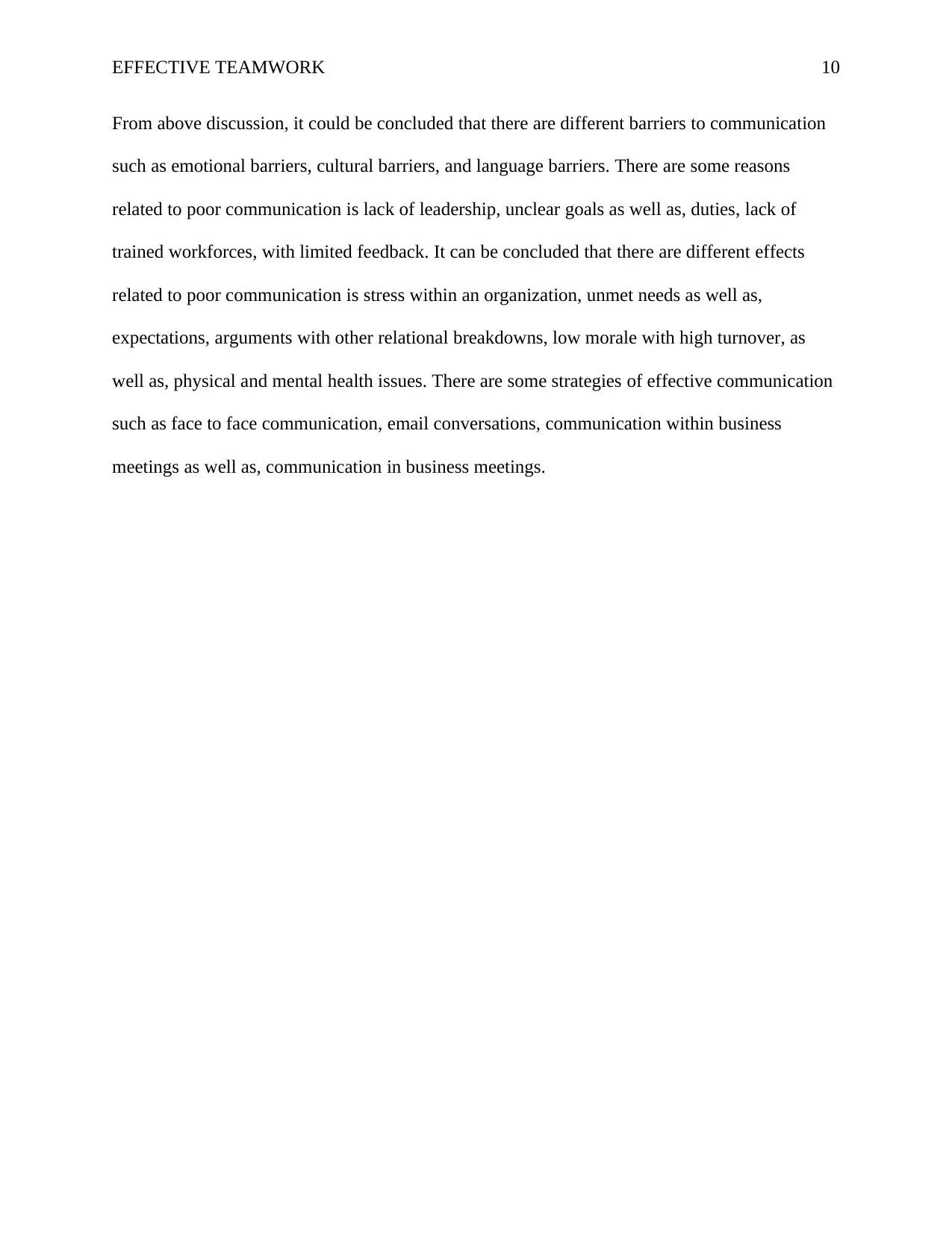
EFFECTIVE TEAMWORK 10
From above discussion, it could be concluded that there are different barriers to communication
such as emotional barriers, cultural barriers, and language barriers. There are some reasons
related to poor communication is lack of leadership, unclear goals as well as, duties, lack of
trained workforces, with limited feedback. It can be concluded that there are different effects
related to poor communication is stress within an organization, unmet needs as well as,
expectations, arguments with other relational breakdowns, low morale with high turnover, as
well as, physical and mental health issues. There are some strategies of effective communication
such as face to face communication, email conversations, communication within business
meetings as well as, communication in business meetings.
From above discussion, it could be concluded that there are different barriers to communication
such as emotional barriers, cultural barriers, and language barriers. There are some reasons
related to poor communication is lack of leadership, unclear goals as well as, duties, lack of
trained workforces, with limited feedback. It can be concluded that there are different effects
related to poor communication is stress within an organization, unmet needs as well as,
expectations, arguments with other relational breakdowns, low morale with high turnover, as
well as, physical and mental health issues. There are some strategies of effective communication
such as face to face communication, email conversations, communication within business
meetings as well as, communication in business meetings.
Paraphrase This Document
Need a fresh take? Get an instant paraphrase of this document with our AI Paraphraser
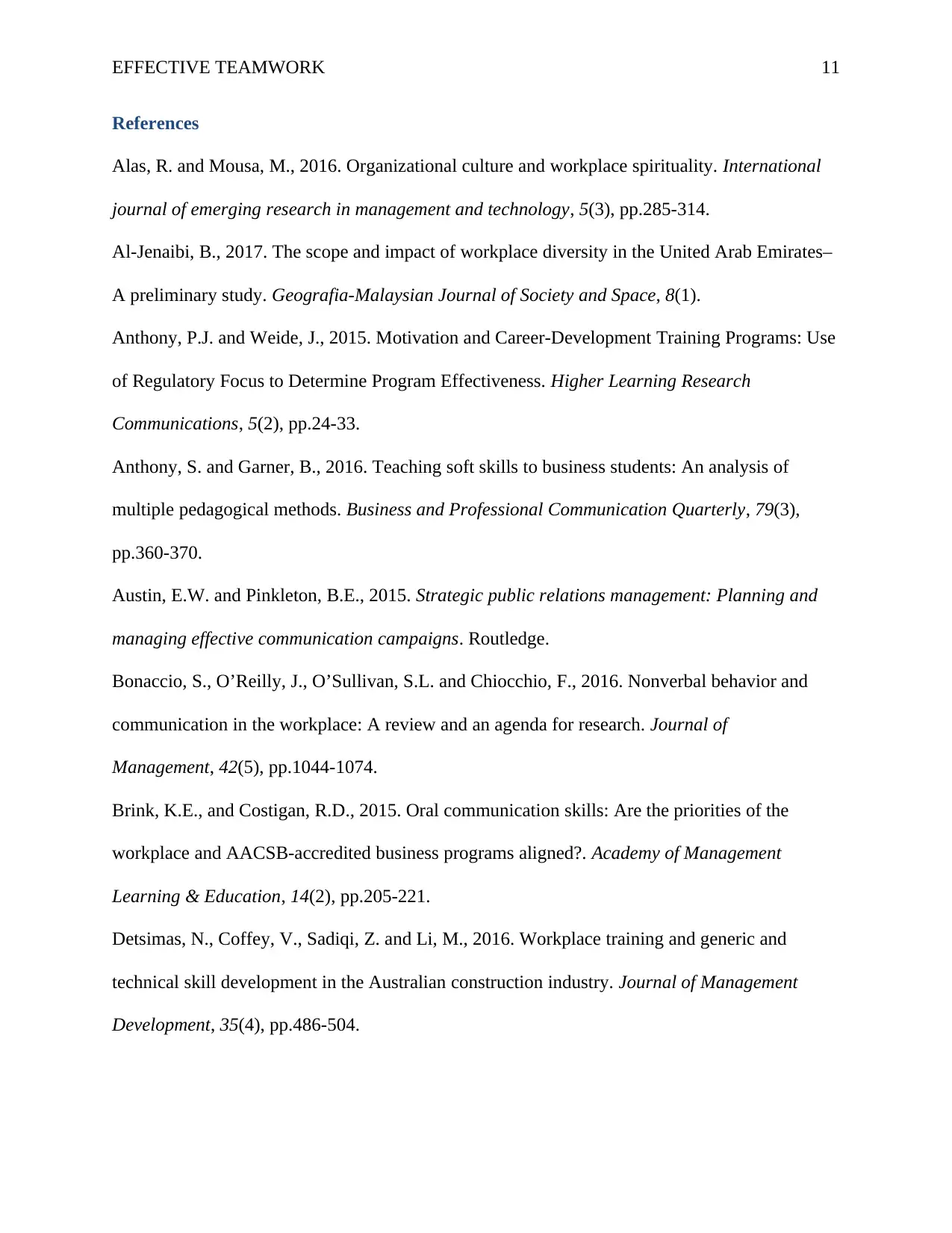
EFFECTIVE TEAMWORK 11
References
Alas, R. and Mousa, M., 2016. Organizational culture and workplace spirituality. International
journal of emerging research in management and technology, 5(3), pp.285-314.
Al-Jenaibi, B., 2017. The scope and impact of workplace diversity in the United Arab Emirates–
A preliminary study. Geografia-Malaysian Journal of Society and Space, 8(1).
Anthony, P.J. and Weide, J., 2015. Motivation and Career-Development Training Programs: Use
of Regulatory Focus to Determine Program Effectiveness. Higher Learning Research
Communications, 5(2), pp.24-33.
Anthony, S. and Garner, B., 2016. Teaching soft skills to business students: An analysis of
multiple pedagogical methods. Business and Professional Communication Quarterly, 79(3),
pp.360-370.
Austin, E.W. and Pinkleton, B.E., 2015. Strategic public relations management: Planning and
managing effective communication campaigns. Routledge.
Bonaccio, S., O’Reilly, J., O’Sullivan, S.L. and Chiocchio, F., 2016. Nonverbal behavior and
communication in the workplace: A review and an agenda for research. Journal of
Management, 42(5), pp.1044-1074.
Brink, K.E., and Costigan, R.D., 2015. Oral communication skills: Are the priorities of the
workplace and AACSB-accredited business programs aligned?. Academy of Management
Learning & Education, 14(2), pp.205-221.
Detsimas, N., Coffey, V., Sadiqi, Z. and Li, M., 2016. Workplace training and generic and
technical skill development in the Australian construction industry. Journal of Management
Development, 35(4), pp.486-504.
References
Alas, R. and Mousa, M., 2016. Organizational culture and workplace spirituality. International
journal of emerging research in management and technology, 5(3), pp.285-314.
Al-Jenaibi, B., 2017. The scope and impact of workplace diversity in the United Arab Emirates–
A preliminary study. Geografia-Malaysian Journal of Society and Space, 8(1).
Anthony, P.J. and Weide, J., 2015. Motivation and Career-Development Training Programs: Use
of Regulatory Focus to Determine Program Effectiveness. Higher Learning Research
Communications, 5(2), pp.24-33.
Anthony, S. and Garner, B., 2016. Teaching soft skills to business students: An analysis of
multiple pedagogical methods. Business and Professional Communication Quarterly, 79(3),
pp.360-370.
Austin, E.W. and Pinkleton, B.E., 2015. Strategic public relations management: Planning and
managing effective communication campaigns. Routledge.
Bonaccio, S., O’Reilly, J., O’Sullivan, S.L. and Chiocchio, F., 2016. Nonverbal behavior and
communication in the workplace: A review and an agenda for research. Journal of
Management, 42(5), pp.1044-1074.
Brink, K.E., and Costigan, R.D., 2015. Oral communication skills: Are the priorities of the
workplace and AACSB-accredited business programs aligned?. Academy of Management
Learning & Education, 14(2), pp.205-221.
Detsimas, N., Coffey, V., Sadiqi, Z. and Li, M., 2016. Workplace training and generic and
technical skill development in the Australian construction industry. Journal of Management
Development, 35(4), pp.486-504.
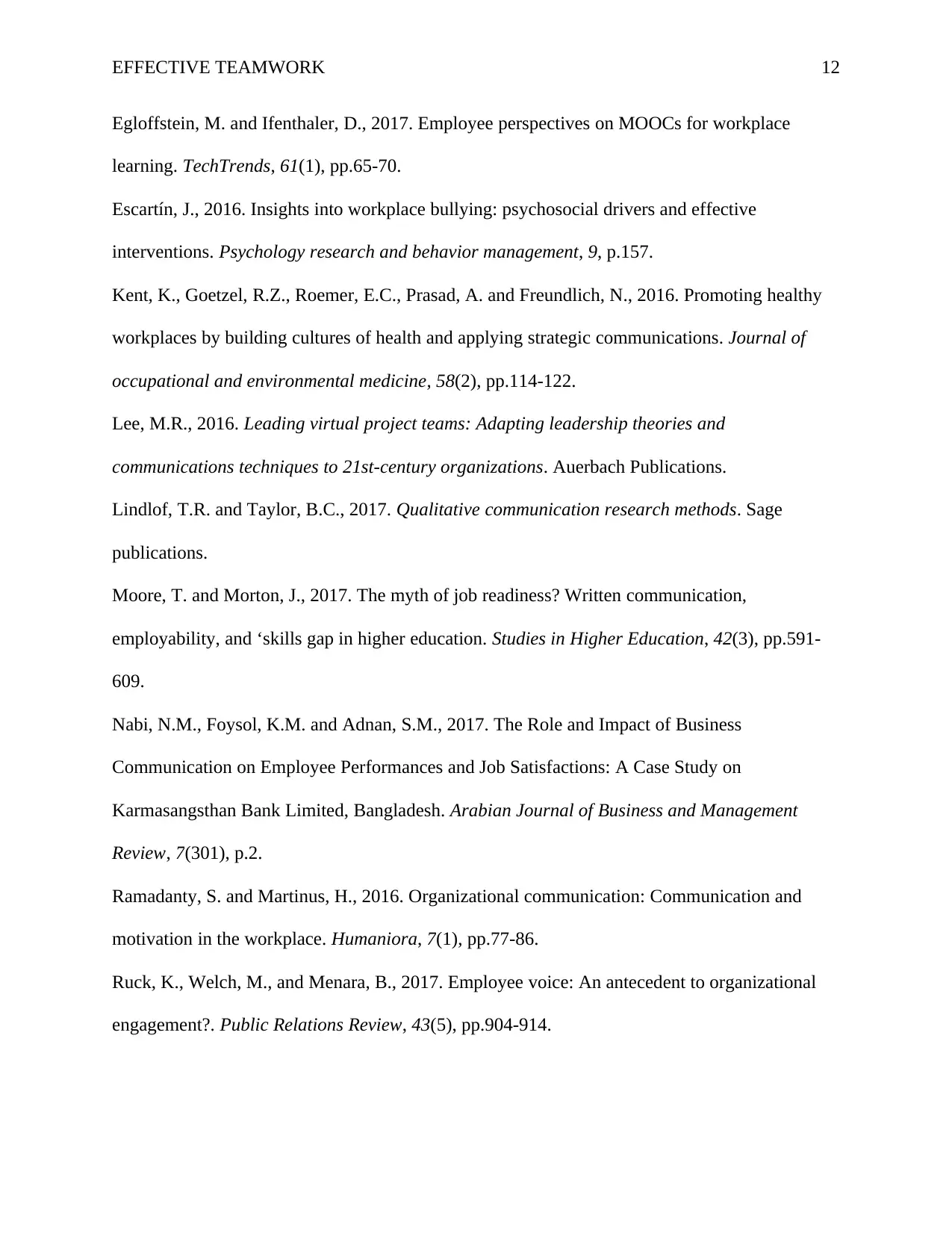
EFFECTIVE TEAMWORK 12
Egloffstein, M. and Ifenthaler, D., 2017. Employee perspectives on MOOCs for workplace
learning. TechTrends, 61(1), pp.65-70.
Escartín, J., 2016. Insights into workplace bullying: psychosocial drivers and effective
interventions. Psychology research and behavior management, 9, p.157.
Kent, K., Goetzel, R.Z., Roemer, E.C., Prasad, A. and Freundlich, N., 2016. Promoting healthy
workplaces by building cultures of health and applying strategic communications. Journal of
occupational and environmental medicine, 58(2), pp.114-122.
Lee, M.R., 2016. Leading virtual project teams: Adapting leadership theories and
communications techniques to 21st-century organizations. Auerbach Publications.
Lindlof, T.R. and Taylor, B.C., 2017. Qualitative communication research methods. Sage
publications.
Moore, T. and Morton, J., 2017. The myth of job readiness? Written communication,
employability, and ‘skills gap in higher education. Studies in Higher Education, 42(3), pp.591-
609.
Nabi, N.M., Foysol, K.M. and Adnan, S.M., 2017. The Role and Impact of Business
Communication on Employee Performances and Job Satisfactions: A Case Study on
Karmasangsthan Bank Limited, Bangladesh. Arabian Journal of Business and Management
Review, 7(301), p.2.
Ramadanty, S. and Martinus, H., 2016. Organizational communication: Communication and
motivation in the workplace. Humaniora, 7(1), pp.77-86.
Ruck, K., Welch, M., and Menara, B., 2017. Employee voice: An antecedent to organizational
engagement?. Public Relations Review, 43(5), pp.904-914.
Egloffstein, M. and Ifenthaler, D., 2017. Employee perspectives on MOOCs for workplace
learning. TechTrends, 61(1), pp.65-70.
Escartín, J., 2016. Insights into workplace bullying: psychosocial drivers and effective
interventions. Psychology research and behavior management, 9, p.157.
Kent, K., Goetzel, R.Z., Roemer, E.C., Prasad, A. and Freundlich, N., 2016. Promoting healthy
workplaces by building cultures of health and applying strategic communications. Journal of
occupational and environmental medicine, 58(2), pp.114-122.
Lee, M.R., 2016. Leading virtual project teams: Adapting leadership theories and
communications techniques to 21st-century organizations. Auerbach Publications.
Lindlof, T.R. and Taylor, B.C., 2017. Qualitative communication research methods. Sage
publications.
Moore, T. and Morton, J., 2017. The myth of job readiness? Written communication,
employability, and ‘skills gap in higher education. Studies in Higher Education, 42(3), pp.591-
609.
Nabi, N.M., Foysol, K.M. and Adnan, S.M., 2017. The Role and Impact of Business
Communication on Employee Performances and Job Satisfactions: A Case Study on
Karmasangsthan Bank Limited, Bangladesh. Arabian Journal of Business and Management
Review, 7(301), p.2.
Ramadanty, S. and Martinus, H., 2016. Organizational communication: Communication and
motivation in the workplace. Humaniora, 7(1), pp.77-86.
Ruck, K., Welch, M., and Menara, B., 2017. Employee voice: An antecedent to organizational
engagement?. Public Relations Review, 43(5), pp.904-914.
⊘ This is a preview!⊘
Do you want full access?
Subscribe today to unlock all pages.

Trusted by 1+ million students worldwide
1 out of 12
Related Documents
Your All-in-One AI-Powered Toolkit for Academic Success.
+13062052269
info@desklib.com
Available 24*7 on WhatsApp / Email
![[object Object]](/_next/static/media/star-bottom.7253800d.svg)
Unlock your academic potential
Copyright © 2020–2025 A2Z Services. All Rights Reserved. Developed and managed by ZUCOL.





